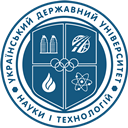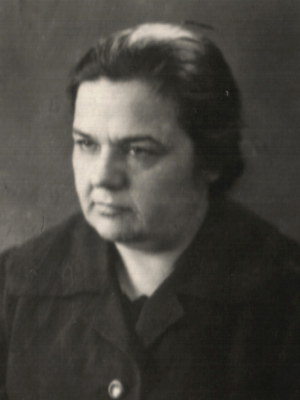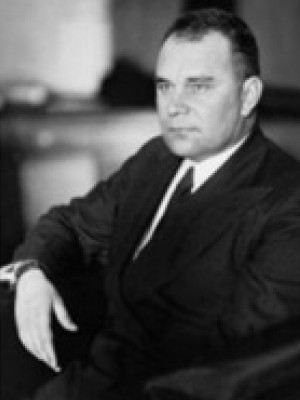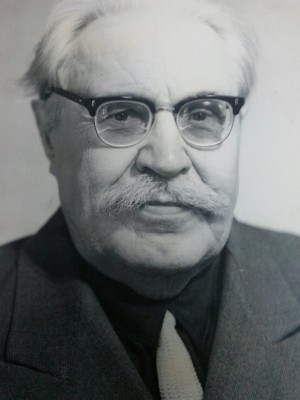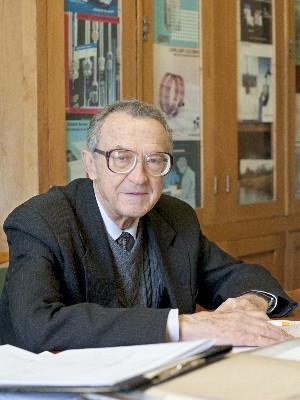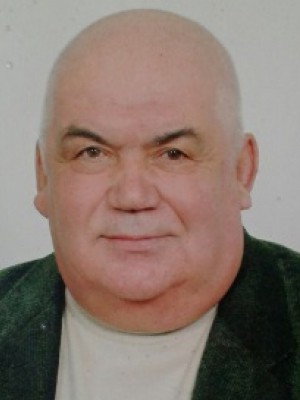DEPARTMENT OF TECHNOLOGICAL SAND, POLYMER AND POLYGRAPHIC MATERIALS
The history of all polymeric chemistry from the time of Soviet Ukraine has been closely intertwined with the history of one great person – Nina Kostiantynivna Moshchinska.
Nina Kostiantynivna Moshchinska (1912-1991)
doctor of sciences,professor, head of theDepartment of PlasticMasses Technology (1955-1975).
Nina Kostiantynivna Moshchinska was born in Arkhangelsk city. She graduated from the Kyiv Polytechnic Institute in 1934. After graduating from the Institute, she worked in the research department of semi-finished products and dyes of the central factory laboratory of the chemical plant in Rubizhne, where she carried out a large cycle of research on the development and introduction of the technology for the production of hydroxynaphthoic acids, dibenzipreninhin, indentrenum, dyes, cobalt golden-yellow and other dyes and products that were at that time the main products of the “Dye”. In 1940, N.K. Moshchinska moved to the position of the teacher at Rubezhansky chemical-technological institute where she worked as an assistant of the chair of Organic Chemistry, Intermediates and Dyes. In 1941, together with the institute, she was evacuated to the city of Kemerovo, after the liberation of the Donbas in 1943, she returned to Rubizhne, where he continued her teaching and work on a Ph.D. dissertation devoted to the synthesis of a number of intermediates for dyes.
After defending the dissertation at the Moscow Chemical Technology Institute after D.I. Mendeleev in 1944, Nina Moshchinska, headed the department of semi-finished products and dyes of the Rubezhansky chemical-technological institute.
After the closure of the RCTh in 1949, Nina worked briefly in the Korean People’s Democratic Republic, and then was sent to the Dnipropetrovsk Chemical Technology Institute, where she worked as an associate professor of the Department of Technology for Basic Organic Synthesis, dean of the Faculty of Technology of Organic Substances. From 1952 to 1954, under the guidance of Professor M.M. Vorozhtsov (MCTII) was engaged in research of processes of condensation of aromatic hydrocarbons with formaldehyde. In April 1955, she defended her doctoral dissertation “Research in a number of diarylmetals and their derivatives”.
With its active participation in December 1955 the Department of Technology of Plastic Masses was founded, which she headed until 1975, and later the Problem Laboratory of Synthetic Polymers and Intermediates was created. In 1957, Nina Moshchinska was approved in the scientific rank of the professor of the founded department.
The Department of Plastic Processing and Film Technology was founded in December 1977 and consisted of two specialties: “Polymer Processing Technology” and “Chemical Technology of Motion Picture Materials and Magnetic Carriers”. In 1998, the Department started educating students in the field of “Photographic materials”. In 2002, a new promising specialty appeared – “Materials of publishing and printing production”.
The graduation of specialists in the fields of “Technology of polymer processing” and “Chemical technology of motion picture and magnetic media” was conducted since 1968 as part of the Department of Technology of Plastic Masses.
From 1977 to 1980, the Department was headed by Ph.D. Inna Petrivna Buriak. Since 1980, professor Eduard Alekseevich Sporyagin headed the Department. From 1992 to 1996, the Department was led by Ph.D. Petro Ivanovych Bashtanik, since 1996, the Department was headed by the doctor of chemical sciences, professor Mykhailo Vasyliovych Burmistr.
In recent years, the Department issued many manuals. Of these, the following are important for the improvement of the educational process at the Department:
- V. Suerlyak, P.I.Bashtannik “Technology of production of products from plastics and composites”, Kiev, 1995;
- V. Suerlyak, P.I. Bastannik “Technology of forming plastic products. Part 2. Technology of formation of molded products “, Kiev, 1996;
- V. Burmistr, NM Evdokimenko and others, “Polymer blends and feeders”, Dnipropetrovsk, 2003;
- V. Burmistr, VS Kravtsov, “Chemistry and physics of macromolecular compounds”, Dnipropetrovsk, 2004;
- V. Suerlyak, P.I. Bashtanik «Technology of processing of polymeric and composite materials», Lviv, 2007;
- V. Burmistr, P.I. Bashtanik, IP Beet,
- V.M. Vishnevetsky, V.G. Ovcharenko «Diploma designing in the specialty« Technology of processing polymers », Dnipropetrovsk, 2011;
- VI Sitar, MV Burmistr, O.S. Kabat “Industrial ecology in the production and processing of polymeric materials”, Dnipropetrovsk, 2012;
- KM Sukhoy, OA Shilova, V.A. Moshnikov, IV Dry, MV Burmister “Fundamentals of sol-gel technology nanostructured oxide and hybrid organo-inorganic materials”, Dnipropetrovsk, 2011;
- A.I. Storm, VV Baigushev MV Bourmist “Carbon-carbon composites-obtaining, properties and application in electrothermy”, Dnipropetrovsk, 2012;
- P. Mamunya, Ye.V. Lebedev, MV Yurzhenko
- VV Levchenko, O.S. Sverdlykovskaya, MV Burmistr, O.V. Chervakov, O.K. Matkovskaya “Polymer Electroactive Materials. Section “Jonnie Liquids”, Kyiv, 2013.
Graduates of the Department are holding the leading positions:
- Victor Aleksandrovich Sinelnik – Director of the Simferopol Plant of Plastics;
- Mykola Vasyliovych Maximov – General Director of Vesna Concern, Dnipropetrovsk;
- Yuriy Vasilievich Brazhnik, Candidate of Technical Sciences – Chief Technology Officer of the Azr Group, Dnipropetrovsk.
In 1925, on the initiative of an outstanding scientist, academician L.V. Pisarzhevskyi, in the Dnepropetrovsk (Yekaterinoslavsky) mining institute as part of the metallurgical faculty was created a chemical and technological department, which began the training of engineers – technologists of coke chemists. In 1930, at the creation of the chemical-technological institute, the department of technology of pyrogenic processes was established, later renamed the department of chemical technology of fuel. Students of all courses were transferred from the mining institute to the SCI and already in 1930 the department – the only one in the SCI – organized the first issue of engineers on fuel technology. The first head of the department was Professor Rubin P.G. Young specialists of the first issues were sent to coke plants of Ukraine and the Urals, as well as in research (Ukhin, Dukhin) and design (DIPROKOKS) institutes. Some graduates were left for work at the department (Savin MI, Shishkin KA, etc.).
In the pre-war years, graduates of the Department: Corresponding Member of the Academy of Sciences of the USSR Sapozhnikov LM, Ph.D. Zashkvar V.G., State Prize Laureate, D.Sc. Agroskin AA, Dr. Sci. Hubergits M.Ya., Dr. Sci. prof. Khanin I.M., Ph.D. Kolandr L.Ya., prof. Didenko V.E. formed the main scientific and management link of the coke industry of the country.
Since 1935, the Department was headed by Doctor of Technical Sciences, Professor Vasyl Ivanovych Dal. The profile of the Department at that time expanded – the training of specialists was started not only for the coke industry, but also for the production and processing of gaseous and liquid fuels; A wide range of research issues was solved. A large group of post-graduate students (Savin MI, Khanin I.M., Shishkin KA, Shapiro M.D., Popov M.L.), who studied at the department, defended their candidate’s dissertations during the prewar years.
During the 2nd World War, the Department was evacuated to Kemerovo, where the training of specialists and research activities on the basis of the Kemerovo Coke Plant continued. Was obtained lubricating oils, and other substances needed for victory and the needs of the front.
After the return of the Institute for evacuation, the brown coal of the Dnipro basin was investigated, ways of its processing were worked out in the processes of semi-coking, gasification, energy technology, briquetting. On this subject, candidate’s theses are defended by Fomenko O.S., Malyarov BM, Vitkin MA, Maltsev AN, Plitom IG, Ruban IM, Nilus SG In connection with the development of the artificial liquid fuel industry since 1946, the training of technologists – specialists in the production of artificial liquid fuel began at the Department. The annual admission to this specialty was 100 people. Such large combines as Angarsk, Salavat, Novocherkasskii were almost completely staffed with specialists – graduates of the DCI. Later, they headed many factories, research institutes, ministries and departments (Radchenko Ye.D., Bludov B.A., Malchevsky A.F., Novitsky V.S.).
The Department of Chemical Technology of Fuel is a pioneer in the field of chromatography for the analysis and study of chemical products of coking, refining of petroleum fractions, gas condensates. According to the results of these works, the doctoral (Doctor of science Nabyvach V.M.) and candidate’s (protected by V.S.P., professor L.S.K.K. Mr. Berlisov Yu.S., Ph.D. Skalozub FI) dissertation.
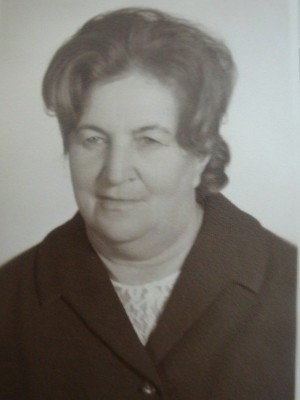 From 1971 to 1981, the Department was headed by Ph.D., associate professor Fomenko O.S. Under her leadership, work was carried out on energy-technological processing of coal from the West Donbass and the Lviv-Volyn deposit. From 1981 to 1983, the Department was headed by Professor Didenko V.Yu., and from 1983 to 1985, Doctor of Technical Sciences, Professor Glushchenko I.M. At that time, work on traditional areas continued – the study of thermocatalytic transformations of hydrocarbons of oil and gas, gas chromatography.
From 1971 to 1981, the Department was headed by Ph.D., associate professor Fomenko O.S. Under her leadership, work was carried out on energy-technological processing of coal from the West Donbass and the Lviv-Volyn deposit. From 1981 to 1983, the Department was headed by Professor Didenko V.Yu., and from 1983 to 1985, Doctor of Technical Sciences, Professor Glushchenko I.M. At that time, work on traditional areas continued – the study of thermocatalytic transformations of hydrocarbons of oil and gas, gas chromatography.
From 1985 to 2007, the Department was headed by Ph.D., associate professor Gulyamov Yu.M. During this period the branch research laboratory for alternative types of fuel joined the department. According to the results of scientific works, candidate’s theses were defended by Stefan Yu.V., Shevchenko O.B., Tertyshnaya O.V.
Over 80 years of existence, the Department has trained more than 4000 engineers – technologists. Graduates continue to occupy a leading position in many enterprises and organizations: Shkarapusha L.N. – zast. Director of the Institute of Bioorganic Chemistry of the Academy of Sciences of Ukraine; Novitskyi V.С. – Minister of the Ministry of Industrial Policy of Ukraine; Bondarev V.V. – General Director of Surgut Gas Processing Plant; Shpak V.A. – zast. Director General of the “Petrochemicals of the Carpathians”; Shaposhnik AV – the head of Azmol research department; Hovanets PM – Chairman of the Board “Kremenchuk Petroleum Product Service”. Doctors of sciences Nabywach V.M., Kharchenko O.V., Snizhko L.O. successfully work at SHEI USUCT.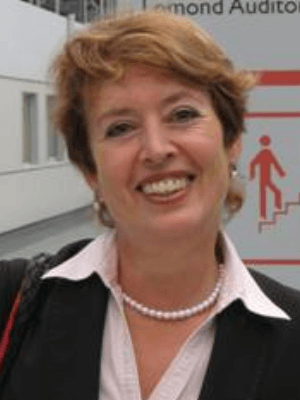
Since 2010, the head of the Department is Doctor of Economics, Professor Liubov Oleksandrivna Snizhko.
The decision to establish a department of rubber technology in Ukraine was adopted by the decree of the VKVS under the SNK of the USSR No. 634 of September 22, 1945.
The Department of Rubber Technology (since 1981 – the Department of Chemistry and Technology of Elastomer Processing) was organized in March 1946 at the Kyiv Institute of Light Industry (KTILP).
The head of the Department was appointed to the chair of the university. Blokh Hrigorii Abramovych. The staff of the Department (there were only 4 people) did a lot of work on the creation of training documentation and special laboratories. Since September 1946, the Department of rubber technology has been successfully operating in Ukraine. The first issue was in 1948.
In order to strengthen the chemical preparation, a decision was made to resettle the department to the Dnipropetrovsk Chemical-Technological Institute (DCI). Since 1954, the department is located in the Moscow State Technical University. 120 students from 2-4 years old arrived in Dnepropetrovsk, the main equipment and the library of special literature were rebuilt.
For many years, the Department was a part of the Faculty of Technology of Organic Substances, from September 2014, the Department of the Faculty of Technology of High-Molecular Compounds.
Until 1965, admission of full-time students to the Department was 20-30 people. Since 1965 – 100 people. At present, students admitted are, in average, 10-30 people to full-time department, and up to 5 people to the correspondence department. In 1959, the Department opened postgraduate studies, in 1980 – doctoral studies.
Over 5,000 engineers of rubber engineers have been trained at the Department in the whole. 7 doctors of sciences and more than 55 candidates of sciences have been trained.
To date, the Department is the only specialized department in the territory of Ukraine, which conducts effective training of specialists in the field of processing elastomeric materials.
- A. Blokh was the head of the Department from the moment of its formation till 1985.
Grigory Abramovich Bloch was born January 23, 1912 in. Yaroslavl in the family of a worker. Graduated from the Yaroslavl Rubber and Chemical College, in 1939 – with distinction from the Chemical Faculty of the Moscow Institute of Light Industry, specializing in rubber technology. Training in the graduate school was interrupted by the Great Patriotic War, whose participant G. A. Blokh was from the first days. He fought on the Western Front in the Yelena region, then parsed in a detachment that operated in the Mozhaisk district of the Moscow region. In November 1945, in Moscow, he defended his Ph.D. thesis “vulcanization of rubber in the presence of vinyl monomers,” in which he showed the ability to modify the properties of rubber and rubber when grafting the monomer to the polymer during vulcanization of the rubber.
- B. Blokh’s teaching activity began in 1943 at the Kharkiv Military School of Chemical Defense. From 1946 he teaches at the Kyiv Institute of Light Industry (KTILP). In Kiev, his active activity began not only in the field of organization of the first department in Ukraine, designed to prepare specialists for the development of rubber industry, but also in conducting research. For a short period in KTILP, special laboratories were created, scientific and methodological recommendations were developed, and the educational process was organized on the specialty “Rubber Technology”. Here H. A. Blokh carried out important researches in the field of studying the processes of vulcanization of rubbers and the mechanism of action of organic accelerators by the method of radioactive isotopes, which were previously initiated at the Institute of Physical Chemistry of the Academy of Sciences of the USSR in the laboratory of Academician AI Brodsky.
In connection with the decision of the Ministry of Higher Education of the USSR on resettlement of the rubber technology department to the Dnepropetrovsk Chemical-Technological Institute (DKHTI), G. A. Blokh moved to Dnipropetrovsk in 1954. In 1960, Hrigory Abramovich successfully defended his doctoral dissertation “Achievements in the field of organic accelerators vulcanization of rubber”. H. A. Blokh was the founder and leader of the scientific direction “Investigation of the processes of vulcanization and modification of elastomers in order to increase the efficiency of rubber”. According to this scientific direction, 10 monographs, 2 of which were published in England and Israel, more than 700 scientific works, received over 70 author’s certificates for inventions. Significant is the personal contribution of G. A. Blokh in the study of the most complex problems of vulcanization of rubber.
They first used the method of isotopic exchange of sulfur atoms to study the mechanism of action and to establish the relationship between the structure of organic accelerators and the effectiveness of their action in vulcanization of rubber. These works were highly appreciated by academician of the Academy of Sciences of Ukraine A.I. Brodsky in the monograph “Chemistry of isotopes” and were published in the USA.
- A. Blokh was a pioneer in the wide study and application of zeolites (molecular sieves) as sorbents of carriers of accelerators, modifiers, structuring agents and other products. With the help of zeolites rubber was obtained with a unique set of properties. More than 30 works by G. A. Blokh in the field of study and application of zeolites were published in the press, and the monograph “Zeolite in the Rubber Industry” (Moscow, 1970) was published.
The same pioneering studies were carried out by them in the field of the use of surfactants (surfactants) as activators in the process of rubber vulcanization. Insignificant additives of surfactant have allowed to reduce in 3-5 times time of achievement of an optimum degree of vulcanization and to get rubber with a new complex of properties. H. A. Blokh ‘s priority in this field was marked by the German scientist with the world name Walter Sheel.
Doctor of chemical sciences, professor H. A. Blokh is listed in the list of 100 most prolific scientists of the world in the field of polymers for the period from 1932 to 1970 gg. In it from the 100 scientists of the world named 17 scientists of the USSR and among them G. A. Blokh.
Academic activity of H. A. Blokh was characterized by a close connection of scientific achievements with industry. The fruitful alliance with the Donetsk Trust “Oblprombitgaz” ended with the introduction of rubber-coated compensators for the connection of underground gas pipelines. Rubber-tile compensators brought not only a significant economic effect to the Donbass gas companies, but also led to the revision of the entire technology of connection of underground pipelines, especially in areas of seismic activity. These and many other examples characterized the breadth of scientific interests of H. A. Blokh and the high efficiency of his work
Professor H. A. Blokh – a man of enormous intuition and unusual good-natured attitude towards people, gave all his knowledge and experience to work for his students and colleagues. Under his guidance 37 candidate and 3 doctoral dissertations were defended. In many of his works, students took an active part.
Professor H. A. Blokh was an active modern figure, a propagandist of scientific and political knowledge, a teacher of youth and students.
Many forces and warmth gave H. A. Blokh a public activity. More than 20 years since 1959, he headed the Dnipropetrovsk Regional Board of the Chemical Society named after D. I. Mendeleev, was a member of the Central Board of the DCT. D. I. Mendeleev.
In 1961, the Dnipropetrovsk government convened its first meeting on chemistry and technology of rubber and rubber, in which 43 reports were made. Under his leadership, the regional organization turned into one of the best, and became the organizer of the following traditional scientific conferences on rubber and rubber, held in Dnipropetrovsk. Continuing the tradition of conducting conferences and the 100th anniversary of the birth of the prominent scientist of the Department in September 2012, another 9th Ukrainian with international participation was held a scientific and technical conference of rubber elastomers: materials, technology, equipment and products.
Professor Blokh H. A.’s social and scientific activities were repeatedly awarded Honorary Diplomas and Medals for high indicators in the training of highly skilled specialists for the national economy. In 1972, he was awarded the Honorary title “Honored Worker of the Higher School of Ukraine”.
- A. Blok managed to leave behind not only numerous scientific works, not only a complex of industrial developments, but the main thing – he brought up allies and students, managed to rally a large team of the department to solve the main task – to bring the chair of chemistry and technology of processing elastomers to the leading positions science and education in the field of elastomeric materials in the USSR. In the building of the faculty of the TOS the nominal educational laboratory was opened in which the employees of the department associate the younger generation with the traditions of the only one in Ukraine, founded by its founder Hrigory Abramovich Blokh.
The follower of H. A. Blokh was Doctor of Technical Sciences Zoia Vasylivna Onishchenko, who headed the Department from 1985 to 1998. Then the head of the department was Doctor of Chemical Sciences, Professor Ebich Yuriy Rakhmielevich, from July 1999 to 2010; from 2010 to 2011 – the head of the Department was doctor of technical sciences, professor Natalia Evdokimenko; and since 2011 to present – the head the Department is Doctor of Technical Sciences, professor Yuri Mykolaiovych Vaschenko,
The Department prepares specialists in the field of chemistry and technology of elastomeric materials. Elastomers differ from the known materials with high elasticity, which ensures the ability of the products from them to withstand large reverse deformations over a wide range of temperatures (-100 to 400 0С). The combination of elasticity, water resistance, gas impermeability, high dynamic strength and other important properties makes elastomers and rubber on their basis irreplaceable design material for the manufacture of tires, conveyor belts, wedge passes, various parts for machine building, shipbuilding, automobile, aviation and many other industries. In Ukraine, there are many factories producing tires (Dnipropetrovsk, B. Tserkov), various rubber products (Kiev, B. Tserkov, Lisichansk, Gorlovka, Sumy, Zaporozhye and others), footwear (m. Kyiv, Chernivtsi, and Gorlovka), restored tires (m. Mykolaiv, Ivano-Frankivsk, Lviv, Donetsk and others), cable products (Berdyansk, Donetsk) and many others.
Therefore, the importance of a specialty is very important for the livelihoods of these enterprises.
In studying the subjects of professional training, students can learn how to formulate formulations of rubber mixtures for different types of tires, rubber technical products (GTV) and shoes, to develop the parameters of the technological process of obtaining rubber products from mixing components to vulcanization. Students get skills in designing rubber industry enterprises, as well as designing and calculating many kinds of rubber products.
During the existence of the department, its team, in cooperation with industry institutes and rubber industry enterprises, is working on solving urgent problems in the field of creating new types of rubber and composite materials based on elastomers.
The most important theoretical and practical researches are devoted to actual problems of vulcanization of rubber, the mechanism of action of accelerators of vulcanization, search of new vulcanizing systems, modification of rubber, creation of special types of rubber for bus, rubber, gas, metallurgical, cable and other industries.
Scientific research is associated with such scholars as Dr. H. N. Blokh Grigory Abramovich, Dr. Sc. Onyshchenko Zoya Vasilivna, d. Ts. Evdokimenko Natalia Mikhailovna, Dr. Sc. Kutyainina Valentina Stepanivna, d. X. N. Ebich Yuriy Rakhmielevich, Dr. Sc. Vashchenko Yurii Nikolaevich, Dr. Sc. Ovcharov Valery Ivanovich, candidates of technical sciences Tarkhov Georgy Vladimirovich, Sheludko Gennady Petrovich, Nosnikov Alexey Fedorovich, Nosnikov Alexander, Melamed Cherna Lvovna, Rapchynska Svetlana Yevgenivna, Tverovskaya Elena Naumovna, Chumicheva Natalya Petrovna, Lotakova Olena Kornelievna, Omelchenko Regina Yakivna, Yemelianov Yuri Valentinovich , Ognevsky Leonid Alekseevich, Pitsik Valentina Antonovna, Shevtsova Ksenia Viktorovna, Stetshenko Nikolay Ivanovich, Tereshchuk Marina Nikolayevna, Boyko Valentina Volodymyrivna, Sverd l Michael Ivanovich, Mary B. Saveliev, M. Natalia Shevchenko, Yuri Kotov L. Kalinichenko Vitaliy M. and others.
Significant impetus in understanding the processes of vulcanization of rubber sulfur and the mechanism of action of organic accelerators became possible in connection with the use of radioactive isotopes. Studies initiated by the department under the direction of G. A. Blokh allowed to determine the mechanisms of action of vulcanizing systems, to develop the physico-chemical bases of creating new types of volcanic agents, accelerators and activators of vulcanization. The results of the research are summarized in the world-famous monographs G.A. Flea.
In January 2012, the staff of the Department celebrated the 100th anniversary of G. A. Blokh’s birth with the opening of a memorial plaque on the facade of the university.
The possibility of obtaining high-quality regenerate from diaphragm rubber based on butyl rubber under the influence of ionizing radiation has been established, which allowed to partially replace the rubber in the corresponding products.
For the first time at the department research was conducted on the use of synthetic and natural zeolite in rubber. The formulations of rubber for various purposes containing zeolite were developed, which allowed replacing expensive and scarce components and significantly increase the complex of properties of vulcanites.
Systematic studies of low-temperature vulcanization allowed to develop vulcanizing systems with the use of double and triple combinations of accelerators that provide vulcanization of general and special rubber at temperatures of 20-100 0С. These systems are widely used, both in the bus and in the rubber industry for the production of adhesives and pastes for repairing tire covers, cold docking of conveyor belts. Together with NIIIRP glues “Titan” and “Sigma”, which have found wide application at the enterprises of the CIS countries.
The Department started work on the use of chlorinated organic compounds in rubbers of various purposes. Today, these compounds are widely used to accelerate the resin vulcanization of rubber, the activation of sulfuric vulcanization processes, the creation of modifying systems, to increase adhesion of rubber to various types of textile cords and metal.
For the first time, work was carried out on the implementation of the system of white soot and the resorcinum-urotropin complex (modifier RU) for a significant increase in the strength of bonding tire rubber with textile cord. The developed system, known as HRH, has been widespread throughout the world.
Pioneering works performed on the Department for the use of oligoesteracrylates. At the present stage, these compounds are widely used in the creation of special purpose rubber.
Polymeric composition GRK-200 for the repair of chemical equipment and equipment operating in aggressive environments at elevated temperatures has been introduced at the enterprises for the production of mineral fertilizers, which greatly simplifies the process of repair of the equipment
The composition of X-ray resin rubber developed at the department was introduced into mass production at the enterprises of the branch.
At the metallurgical enterprises, a rubber cartridge container was introduced instead of a metal for transporting hot metal samples for rapid analysis from a blast furnace or martin to a pneumatic post over the pipeline, which greatly reduced the weight of the container and noise during its transportation.
Work on the study of the mechanism of action in the rubbers of surfactants allowed the introduction of a system based on monoethanolamides of synthetic fatty acids, synthetic fatty acids fr. C21-25, which allowed the replacement of stearic acid, which is made from food raw materials
Scientific activity at the department is closely connected with the creative interests of students. The most capable students are involved in conducting research on the main scientific areas of the department, participating in works of republican and international conferences of students and young scientists, participating in various contests.
The research results of the Department staff are constantly reported at scientific and technical conferences of different levels in Ukraine, Russia, Germany, Poland, Bulgaria. Relevance of the conducted researches is confirmed by received more than 220 certificates of authorship and patents. The department’s staff published more than 900 articles and 20 monographs, some of which were published in the UK, among which are the following: G. A. Blokh “Organic accelerators and vulcanizing systems for elastomers” (editions 1964, 1972 and 1978); Averko-Antonovich Yu. O., Ebich Yu. R., Omelchenko R. Ya., Okhotina NA “Technology of rubber products” (1991); “Properties of rubber compounds and rubber: assessment, regulation, stabilization” / Under the general editorship of VI Ovcharov (2001); Evdokimenko N. M., Burmist MV, Kotov Yu.L., Vaschenko Yu.M. “Polymer Mixtures and Composites” (2003)
The Department is the organizer of scientific and technical conferences for 65 years, which collect people devoted to the business of elastomeric materials from many corners of the near and far abroad. During the years of Ukraine’s independence, the Department organized 10 international scientific and technical conferences.
In 2012, there was 100 years since the birth of Grigory Abramovich Blokh – a major organizer of science, who had state thinking, a talented scientist, educator, educator of scientific youth, the organizer of the only technological department in Ukraine.
